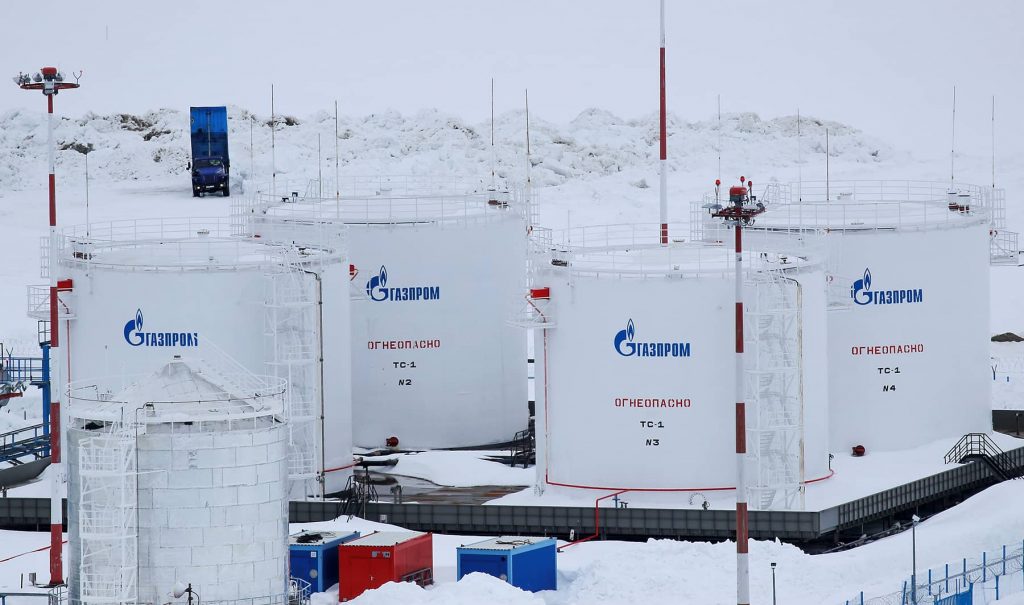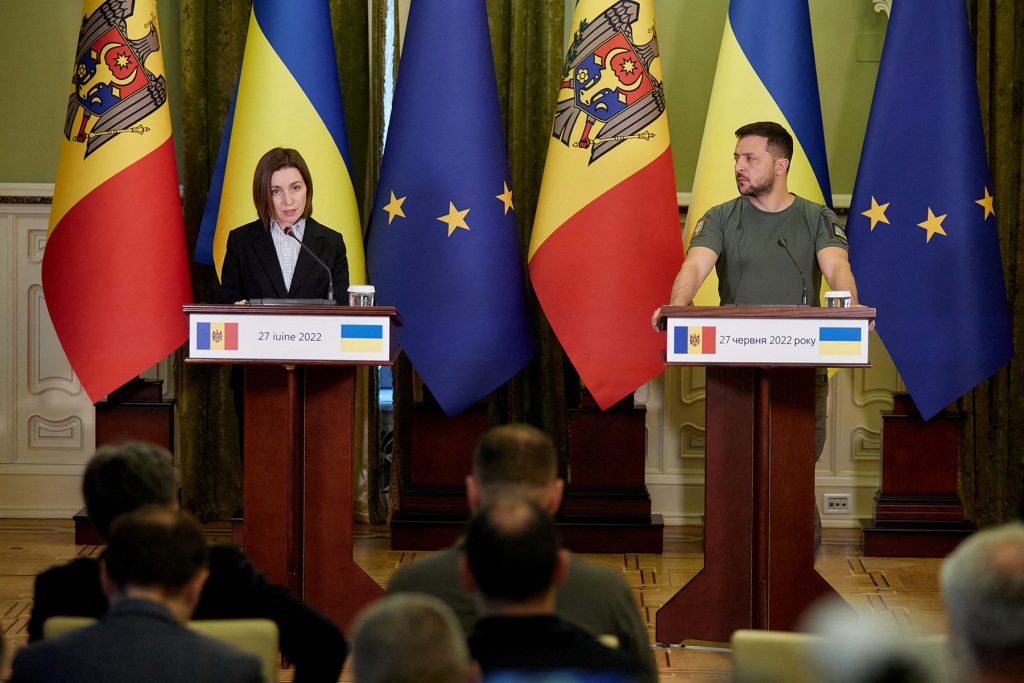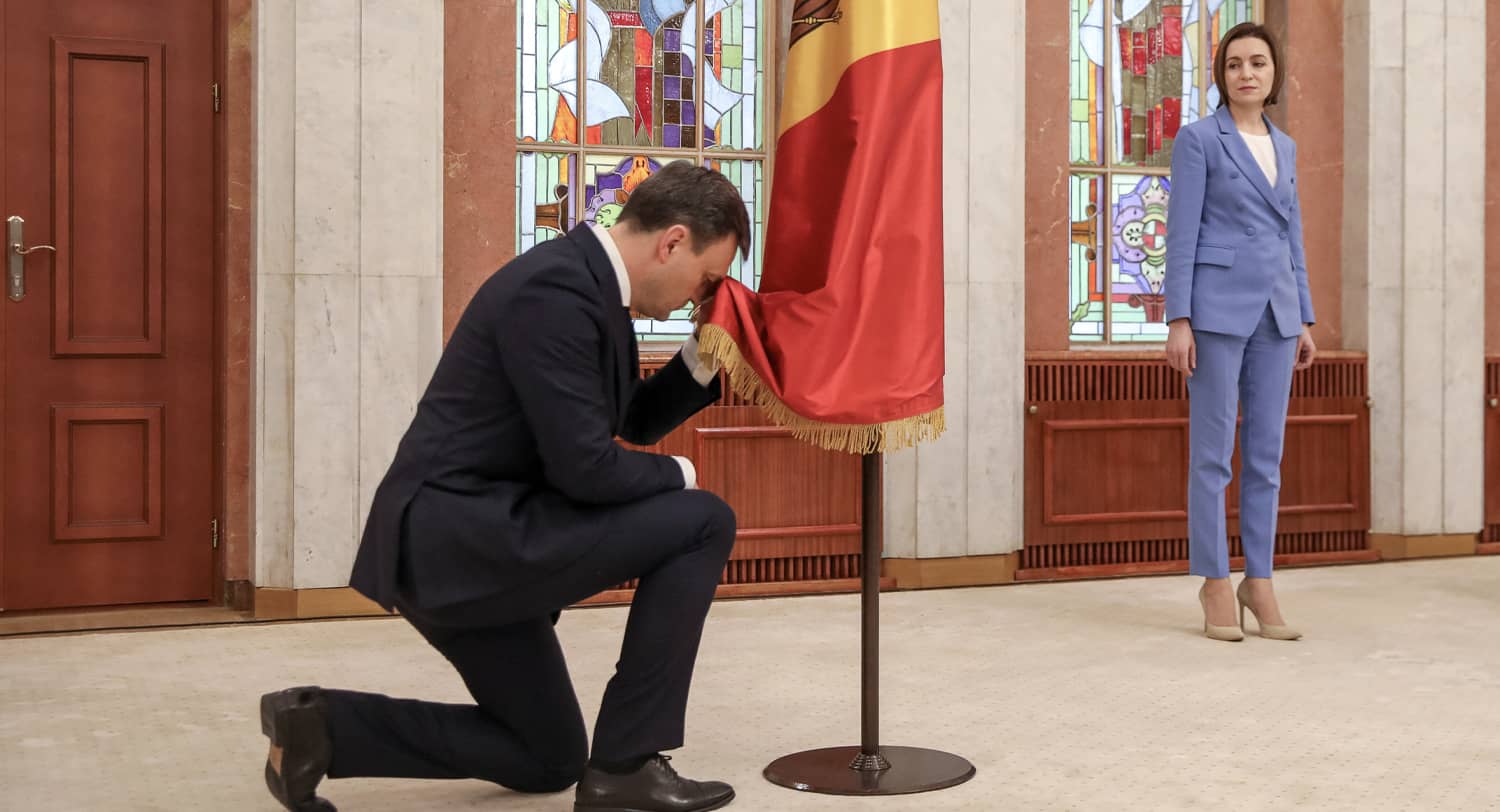To avoid receiving an energy bill she couldn’t afford, Zinaida Negruti, like countless others in Moldova, began spending more time in the dark as fall transitioned into winter. “Most of the time I don’t turn on the lights because I am worried it will be too expensive,” she says. “I try to use as little as possible.”
Beginning in fall 2022, drastic spikes in the costs of electricity made an already precarious situation in Moldova unbearable for citizens like Negruti, a 67-year-old retired teacher from Telenești, a small town 91 kilometers northwest of the capital Chișinău. On a Sunday afternoon in late November, she joined an opposition-led protest outside the Presidential Palace with thousands of others. “We’re not against Maia [President Sandu] as a person, we are against the politics that they lead,” explained Negruti.
This is a story of how Russia used its natural gas exports to squeeze an energy-dependent European country, leading to the fall of its prime minister and the potential derailing of the country’s pro-European Union trajectory.
Moldava is historically reliant on natural gas provided by the Russian state-controlled energy company Gazprom. In October 2022, Gazprom suddenly cut natural gas supplies to Moldova by 30% and deepened the cuts to 40% by November, citing outstanding payments Moldova allegedly owed the company. Gazprom provided 100% of Moldova’s gas prior to the cuts, placing the company in an advantageous position to exercise leverage over Moldova’s domestic stability.

The sudden reduction led to utility bills eating up as much as 75% of an average Moldovan family’s income, according to President Sandu. The resulting public protests, while sustained by legitimate concerns of a population long suffering from a weak economy and a corrupt state, have been primarily organized by opposition parties close to Russia, in an apparent effort to undermine the credibility of the Sandu government as it builds closer ties with the European Union and the United States.
A country of 2.6 million people and former republic of the USSR, Moldova rests between Ukraine to the north and NATO member Romania to the south. It is one of the poorest countries in Europe. Transnistria, a Russian-speaking separatist state allied with Moscow, runs along the north side of the Dniester River and the Ukrainian border for about 250 miles. It has been semi-autonomous since 1992. Home to 470,000 people, the breakaway state hosts an estimated 1,500 Russian soldiers and is the site of the Cuciurgan power plant, the largest in Moldova. Romanian is the official language of Moldova, although Russian is recognized as a minority language.
Gazprom’s decision to reduce supply to Moldova came at a critical moment, as the government of President Sandu and Prime Minister Natalia Gavrilița worked toward implementing reforms necessary for joining the EU.
Only two other countries in Europe, Bosnia and Herzegovina and North Macedonia, are as dependent on Gazprom as Moldova. Complicating matters further, Transnistria, home to the Cuciurgan power plant, was previously responsible for providing 70% of Moldova’s electricity, powered also by gas from Gazprom, while the remaining 30% of electricity was imported from Ukraine. When Gazprom announced its reduction of supply, the government of Transnistria also froze electricity supply to Moldova proper, citing the need to prioritize its own territory. Simultaneously, supply from Ukraine was halted after Russian forces stepped up attacks on Ukraine’s energy infrastructure. These factors combined resulted in the sharp increase in electricity prices as Moldova bought more expensive gas from Romania to meet needs.
In a statement released on Twitter, Gazprom claimed supplies to Moldova were cut due to Moldovagaz, a Moldovan energy company where Gazprom is the majority shareholder, which had violated “contractual conditions as regards terms of payment.” Ukraine was also accused of blocking gas to Moldova, a claim both the Ukrainian and Moldovan governments rejected.
Under the terms of a five-year contract signed in October of 2021, prices for gas fluctuate on a monthly basis and are determined by the spot market price, which has increased as a consequence of the war in Ukraine. Additionally, being able to leverage Moldova’s dependency on the Cuciurgan power plant, the separatist region of Transnistria refuses to pay for the gas it uses, estimated to be 1.7 billion cubic meters of gas annually, with Moldova using 1.3 billion annually. While the Moldovan state refuses to recognize the debt accrued by Transnistria, Gazprom holds Moldova responsible for an estimated $9 billion. Gazprom also alleges that Moldovagaz owes $700 million for gas delivered before 2019, although Moldovan President Maia Sandu has argued that only debt verified by an independent auditor will be acknowledged as legitimate.
By December, Gazprom was providing 5.7 million cubic meters of gas per day to Moldova, of which 3.4 million was used by Moldova while the remaining 2.3 million was used by Transnistria. Moldova used about 11 million cubic meters of gas per day in December. From December onward, Moldova began purchasing more expensive natural gas from the open market with the help of EU financial assistance, while sending the Gazprom supply to Transnistria.
“We interpret this as the blackmailing of Moldova,” explained Alexei Tulbure, a former diplomat and ambassador to the United Nations and the Council of Europe who now works to counter Russian disinformation aimed at Russian-speaking Moldovans.
“It’s a hybrid war against Moldova, since we don’t have bombings here, tanks and so on, but they fight with us with other means. Why? Because Moldova has a pro-European government.”
In August 2021, the government led by Prime Minister Natalia Gavrilița entered office after President Maia Sandu, who was elected in December of 2020, successfully called for early parliamentary elections in July. The election saw Sandu and Gavrilița’s party, the Party of Action and Solidarity (PAS), win 63 of 101 seats. The remaining seats are divided between opposition parties, the Bloc of Communists and Socialists (BCS) with 32 seats, and the Șor Party with six seats. The current government has prioritized integration with the EU and on March 3, 2022, President Sandu signed the application for EU membership. Both Moldova and Ukraine were granted candidate status on June 23. Moldova is also hosting an estimated 95,000 Ukrainian refugees and has worked with the European Bank for Development and Reconstruction to develop overland logistical routes for Ukraine, deemed Solidarity Lanes.
The high energy bills for ordinary Moldovans also comes at a time of record inflation rates of almost 34%, a situation that opposition parties, such as the Șor Party, were quick to blame on the Sandu and Gavrilița government.
The Șor Party is led by Ilan Shor, an Israeli-born former mayor of Orhei who is wanted on corruption charges in Moldova. Shor fled the country for Israel in 2019, although he still leads the party. He has been implicated in the theft of $1 billion from three banks in 2014 and is allegedly connected to Russian intelligence agencies. Shor is also one of nine individuals recently targeted with sanctions by the US Department of Treasury for working on behalf of the Russian government in Moldova. In November, Moldova’s Minister of Justice Sergui Litvinenco filed an appeal to the country’s Constitutional Court that seeks to classify the Șor Party as unconstitutional. The party has been accused of paying people to participate in the weekly protests in an attempt to opportunistically direct frustrations toward the Sandu government. The Șor Party did not respond to contact attempts for comment.
According to Acting Prosecutor General Ion Munteanu, investigations carried out by the Prosecutor’s Office have concluded that many of the protestors are being paid to participate in the protests.
“The aim behind these protests, clearly, we shall recognize it, is to prevent the development of a rule of law that would ensure an independent and efficient justice system,” he explained.
“The Republic of Moldova is the object of a war, but not necessarily with the help of the weapons, but a war of different kinds, including energy, information, and one of another nature, which would aim to impede the general purpose assumed by the current government—to choose the European path of development.”
According to Negruti, who said she attended the protests on her own initiative, “most of the people here don’t really care who is in charge, what is most important is that they work for the people and make life better for everyone,” she explained.
A poll from early December indicated that only 20% of Moldovans were satisfied with the Sandu and Gavrilița government, suggesting that harsh living circumstances and opposition narratives are having an effect on perceptions. Although the EU allocated $250 million in aid on November 10, which was followed up with another $100 million at a donor conference on November 21, and another $30 million from the United States Agency for International Development (USAID) in January to help the Moldovan government pay for energy and alleviate some of the pressure caused by the manufactured gas crisis, the pressures have only increased. Moldovans remain plagued with high costs of living and a struggling economy, despite an unusually moderate winter.

On February 10, 2023, Prime Minister Natalia Gavrilița resigned, citing Russian aggression in Ukraine and its consequences. Shortly before this announcement, Russian cruise missiles flew through Moldovan airspace en route to targets in Ukraine. Russian missile debris has repeatedly entered Moldova during attacks on Ukraine. The day before, Ukrainian President Volodymyr Zelenskyy stated his government had intercepted Russian plans for the “destruction of Moldova,” which was shared and confirmed by Moldovan intelligence.
Four days later on February 13, President Sandu alleged a coup was being planned by Russian operatives with the use of saboteurs and protests of the “so-called opposition.” Sandu specifically listed Ilan Shor and Vladimir Plahotniuc as participants, both of whom were subject to last year’s sanctions implemented by the US and the UK. Plahotniuc is an oligarch and former member of parliament and leader of the Democratic Party who has been implicated in widespread corruption, including the theft of $1 billion along with Ilan Shor.
Amid this series of unfolding crises, Russian Foreign Minister Sergey Lavrov stated on February 4 that the West had “set its sights on the Republic of Moldova to have the role of the next Ukraine.” To what extent this comparison will reflect reality remains to be seen.

